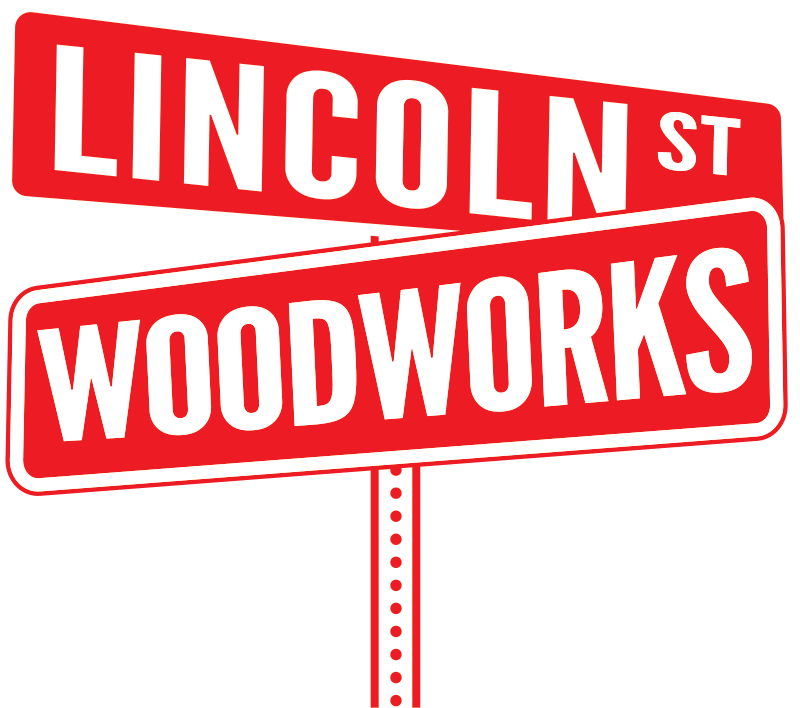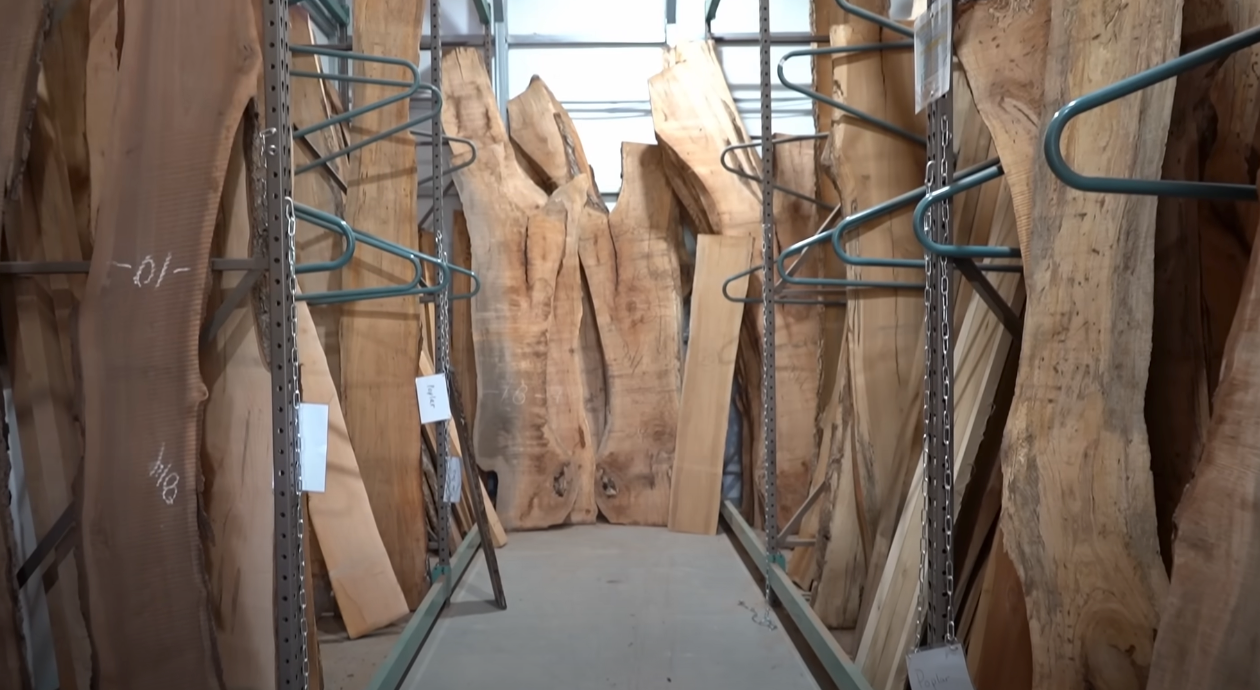I headed out to pick up some lumber for an upcoming project—and figured it was a great time to help you navigate the weird, confusing, occasionally shady world of buying wood.
First things first: meet my buddy Matt Morgan, owner and operator of M2 Lumber in Laurens, South Carolina. Matt runs his sawmill on his personal property, which includes:
-
Two kilns
-
A fully decked-out wood shop
-
A whole lot of lumber
-
A sawmill to cut said lumber
-
A big-ass tractor I really wanted to drive (He didn’t let me. Total buzzkill.)
 Drying Wood: The Non-Negotiable Step
Drying Wood: The Non-Negotiable Step
Before we dive into what Matt has in stock, let’s talk about one of the biggest red flags when buying from smaller operations: improperly dried wood.
Why Kiln Dry?
-
Moisture Content – Green wood (freshly cut) is soaked—often over 50% moisture. A 5,000-pound log can have a literal ton of water in it. As the wood dries, the cells shrink and shift. If that happens after you build something? You’ve got a warped mess.

-
Bugs – Every tree’s got creepy crawlies living inside. Even if you can’t see them. Some leave when the tree’s cut. Others... move in. The bug housing market is brutal.
 To evict them: crank the heat. 135°F for at least an hour does the job.
To evict them: crank the heat. 135°F for at least an hour does the job.
The Most Common Mistake
The #1 mistake people make buying from local sawmills? Not verifying that the wood has been properly kiln-dried.
As a sawmill operator, it’s Matt’s job to prove it’s dry. Don’t be afraid to ask for moisture content—and ask them to show you.
Wood dries from the outside in, so a cheap moisture meter with shallow probes? Totally misleading. You’ll get a “dry” reading even if it’s still soggy in the center.
 Matt uses a Delmhorst J2000 moisture meter with two-inch probes. It reads deep into the wood. His sample read at 14%—generally, you want under 12% depending on your climate. In drier areas (hey, Arizona), aim for 5–6%.
Matt uses a Delmhorst J2000 moisture meter with two-inch probes. It reads deep into the wood. His sample read at 14%—generally, you want under 12% depending on your climate. In drier areas (hey, Arizona), aim for 5–6%.
What If You Can Only Find Green Wood?
Sometimes, you don’t have a choice. There are chemicals to kill bugs on green wood. But the real issue is time.
Rule of thumb? One year per inch of thickness to air-dry. I once bought green lumber I loved and waited nearly two years for it to be usable. So yeah—budget for dry time and proper stacking space.
I once bought green lumber I loved and waited nearly two years for it to be usable. So yeah—budget for dry time and proper stacking space.
Pro tip: Properly stickering your boards (aka separating them with little spacers for airflow) is key. Think of wet wood like a spaghetti noodle—it molds to whatever shape you leave it in. So lay it right.
How Lumber is Priced: Welcome to Board Feet
Lumber is sold by volume—measured in board feet. It’s simple:
Length × Width × Thickness (in inches) ÷ 144 = Board Feet
Thickness is always referred to in quarters of an inch:
-
4/4 = 1 inch
-
6/4 = 1.5 inches
-
8/4 = 2 inches
 What Affects Price?
What Affects Price?
-
Species – Popular woods with limited supply cost more.
-
Thickness – Thicker boards take longer to dry. More time = higher cost.
-
Cut type – Quarter-sawn or rift-sawn boards are more stable and often come with a surcharge.
And if someone on Facebook Marketplace is charging nearly the same for green wood as local kiln-dried prices? You’re getting scammed, my friend.
What’s a Fair Price?
Good question.
It depends where you live. Walnut in the Southeast is common—and cheaper—than in the Southwest where it doesn’t grow.
Start by checking your local hardwood dealer for a baseline. No local source? Try Facebook groups or Reddit to compare prices in your area. If a sawmill is charging 15–20% more than the going rate? Nope. Walk away.
What Kind of Wood Should You Buy?
Matt says the most common question he gets—by far—is:
“What type of wood should I use for my project?”
That could be a whole video series, but here are the three questions to answer before buying:
-
What are you building?
-
What will it be used for?
-
Where will it live (indoors, outdoors, humid basement, etc.)?
Quick Examples:
-
Outdoor + bug-resistant? Go with cedar (lightweight, not super strong).
-
Stylish indoor project? Walnut. Gorgeous. Instagram gold. Terrible outdoors. Expensive.
-
Strong outdoor wood? White oak. Tough, dense, naturally rot-resistant.
The Slab Life
Let’s talk slabs. You epoxy river table folks know what’s up.
For wide projects like tables or bar tops, slabs are awesome—but they come with quirks.

Things to Watch:
-
Pith & cracks – Most wide slabs come from the center of the log, which often means cracks. It’s normal. You’ll need bowties, epoxy, or C-channel to stabilize them.
-
Price – Anything wider than 16" usually costs more. Wide logs are rare, heavy, and hard to cut.
-
Grain & figure – Beautiful grain (burl, curl, spalting) ups the cost. Spalting is a fungal pattern that’s gorgeous when dried and safe—but it can reduce strength, so you’ll want to reinforce it.
Book-Matched Slabs
 These are two slabs cut from the same log, kept together and opened like a book. They mirror each other. They're beautiful. They're in demand. They cost more. But they're worth it.
These are two slabs cut from the same log, kept together and opened like a book. They mirror each other. They're beautiful. They're in demand. They cost more. But they're worth it.
Flattening Slabs
Flatten slabs can usually be done in-house (for a fee). Or, you can do it yourself with a flattening jig. But heads up:
The longer and thicker the slab, the more material you’ll remove.
That 10' x 3" slab won’t stay that size after it’s milled flat.

Not All Dimensional Lumber is the Same
You’ll hear terms like quarter-sawn, rift-sawn, and flat-sawn. These refer to how the log was cut and what grain pattern it yields.
-
Flat-sawn – Most common, most unstable.
-
Quarter-sawn – More stable, grain is vertical to the face.
-
Rift-sawn – Super straight grain, labor-intensive, expensive.
Quarter and rift cuts reduce movement and are ideal for high-end furniture.


Matching Boards = Pro-Level Move
One of the best reasons to buy from a local sawmill? You can get multiple boards from the same tree. That means color and grain consistency—huge for furniture builds.
All the hickory I picked out for this project? From one tree. No surprises.
Also: I check board width. My jointer is only 8", so wide boards = more waste. And yes, I double-check for warps or twists, even with Matt’s excellent stacking.

Matt’s Business Model = Your Benefit
Here’s how big box hardwood dealers work:
-
Logger → Sawmill → Kiln → Broker → Warehouse → You
Here’s Matt’s model:
-
Tree → Matt → You
Fewer steps. Less freight. Lower cost.
The only downside? He can only mill local wood. So no Purpleheart here in South Carolina.
But species like ash, walnut, cypress, cedar, pecan? All good.

Bonus: Matt mills urban lumber. 80% of his logs come from trees that would’ve ended up in landfills. That’s why their motto is:“Save the Trees.”
If They Don’t Have What You Need—Don’t Buy
After all that, Matt didn’t have everything I needed for this project. And that’s okay.
Sometimes you go to a mill, look around, and leave empty-handed.
Don’t feel obligated to buy just because you’re there.
Wood is expensive. Wait until it’s right.



Share: